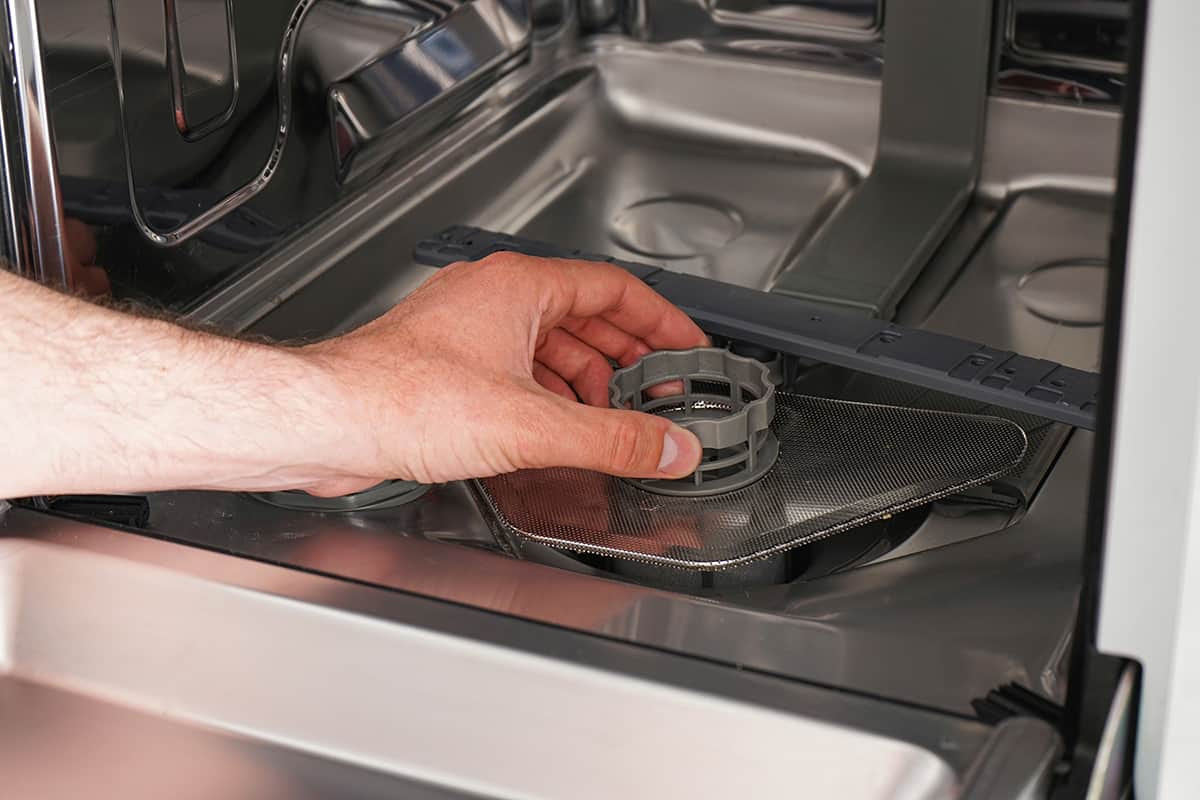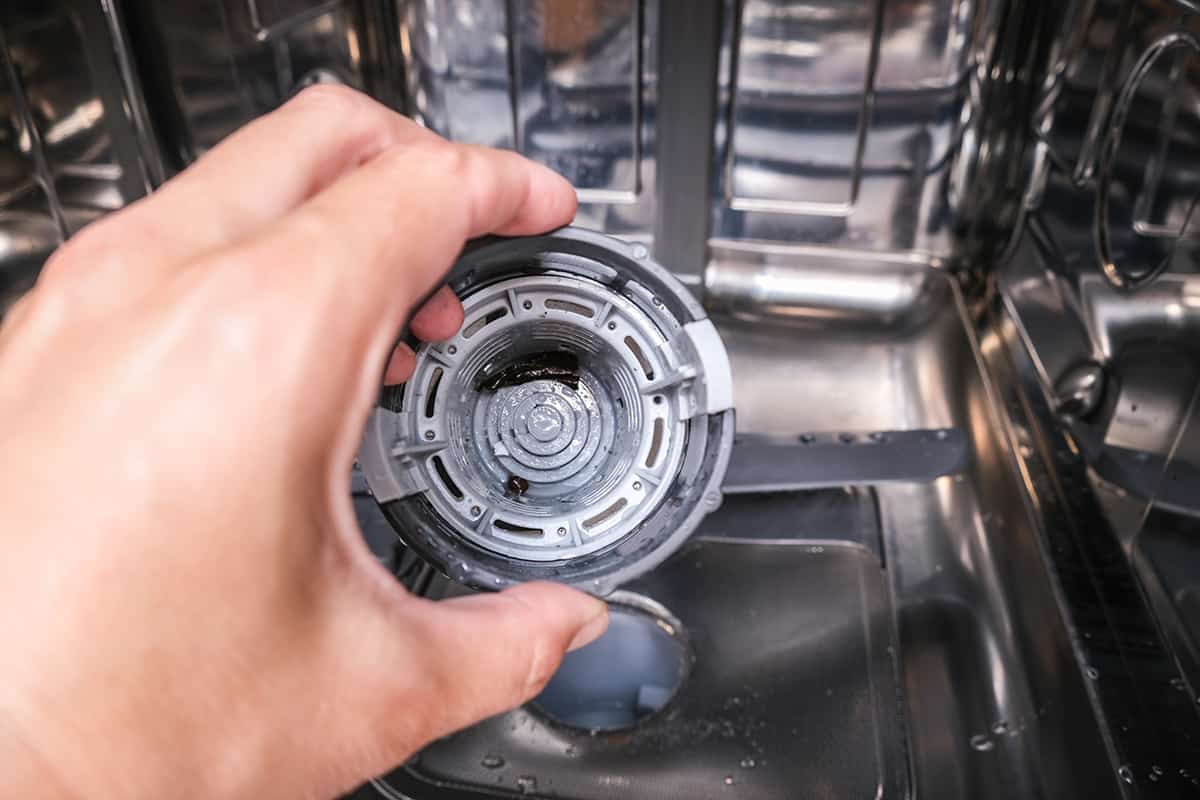In a dishwasher, a filter serves to prevent food remnants from making their way into the sewer line. Without it, your pipes would become clogged more frequently, and it would be a hassle to dismantle the drain lines to manually remove the solid buildup. So, where can you find the filter in a Frigidaire dishwasher?
If you open the Frigidaire dishwasher, you’ll find the filter assembly located on the base. Depending on the model, the filter will consist of 3 components: the main filter, the cup, and the cylindrical filter.
In this guide, I’ll show you the proper steps on how to thoroughly clean a Frigidaire dishwasher’s filter. I’ll also explain how frequently you should clean the filter and what other maintenance steps you should follow to ensure optimal dishwashing performance.
Where Is the Filter in a Frigidaire Dishwasher?

All dishwashers, including those made by Frigidaire, will come with a filter. The purpose of the filter is to stop solid particles from entering the drain line of your kitchen sink, which could lead to a buildup that’s difficult to remove if left untreated.
In a Frigidaire dishwasher, you can locate the filter by pulling the door, removing the dishracks, and examining the base of the dishwasher. There, you’ll find the circular filter assembly.
If you remove the filter, you’ll find that it consists of 3 parts. The first is the main filter, which is used to trap larger particles and stop them from entering your drain. The second part is the cup unit, which holds the main filter and the third and final component, the cylindrical filter.
As you can see, Frigidaire dishwashers come with a multi-tier filtration system that prevents large and fine particles from swirling down the drain. Over time, the filters will become clogged with several cycles’ worth of food remnants and need to be manually cleaned.
How to Clean Frigidaire Dishwasher Filter?
Clearing a Frigidaire dishwasher’s filter assembly is pretty straightforward. Before you get started, make sure you head over to the Frigidaire website and download the owner’s manual for your exact dishwasher unit. The manual will contain the exact steps you must follow to clean the filter assembly.
However, if you’re short on time, this 4-step guide should help you locate, clean, and reinstall the filter assembly in no time.
Step 1—Shut off the dishwasher
First and foremost, you must ensure that your Frigidaire dishwasher is turned off. You can do so by hitting the power button and waiting a few seconds for the system to turn off completely. For good measure, unplug the power cord if possible; otherwise, turn off the circuit breaker.
Step 2—Locate the filter assembly
Consult the owner’s manual to locate the filter. In most Frigidaire dishwasher models, you can locate the filter assembly by removing the dishracks. The filter assembly should reside at the center of the dishwasher’s base. You might need to twist the filter counter-clockwise to release it from the filter port.
Step 3—Remove the filter assembly and wash
Grab the filter assembly and pull it out of the filter port. Disassemble the filter and wash the 3 components separately. Use soapy water to remove any caked-on residue and grease, of which there will be plenty. Rinse thoroughly with cold water and, if necessary, use a brush to scrub away any solid particles hanging on the filter’s mesh and cup.
Please exercise caution when cleaning the cylindrical filter as its mesh can break with excessive force. I recommend submerging the filter in soapy water, letting it sit for 5-10 minutes, and rinsing with cold water. You can also submerge the filter in a 1:4 bath of vinegar and water to help dissolve any stubborn bits on the fine mesh.
Step 4—Reassemble the filter and reinstall in the dishwasher
Finally, put the filter assembly together. Place the cup inside the cylindrical filter before resting the main filter on the cup’s brim. Now, pop the filter assembly back into the filter port found at the bottom of the Frigidaire dishwasher’s interior before replacing the dishracks.
How Often Should I Clean the Dishwasher’s Filter?

It’s recommended that you remove the filter assembly and wash the components once every 3-6 months. However, how frequently you should clean the filter will depend on how often you use the machine.
For instance, if you stick to a 5-cycle-per-week schedule, then you will have to clean the once every 3-4 months. If you use your dishwasher sparingly, you could let the filter assembly sit for up to a year before solid waste becomes a problem.
Signs of a Clogged Filter
The following signs indicate that you should have washed the Frigidaire dishwasher’s filter several days, if not weeks, ago.
Standing water—While standing water can be a sign of all kinds of dishwasher problems, the most common cause is a dirty filter. This can lead to mold and bacteria growth, which can wreak havoc on the inner workings of your dishwasher. So, if your dishwasher can’t flush water quick enough, turn the unit off and inspect the filter before running any more wash cycles.
Dirty dishes—No matter how many cycles your dishes go through, they still come out with grimy bits clinging to the surface. This is caused by the spray arm flinging up dirt particles that have been trapped in the filter.
Odors—As you can imagine, the longer old food remnants stay at the bottom of your dishwasher, the smellier they will become. No amount of soap and vinegar can get rid of the smell of solid food particles that have been continuously moistened through multiple dishwashing cycles.
Can I Run Dishwasher Without Filter?
Under no circumstances should you attempt to run your dishwasher without installing the filter assembly first. Also, make sure the filter assembly is locked in place before running a wash cycle.
While tiny bits of old food might not seem like a problem, over time, the bits can group together to create a large blockage inside your drain pipes. When this happens, you have 2 choices: manually remove the blockage by disassembling the kitchen drain line or calling a plumber to do it for you.
If you like this article, be sure to check these out.






